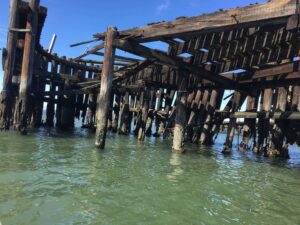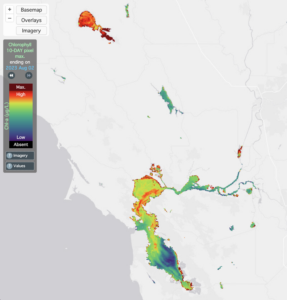When John Takekawa first started monitoring waterbirds 30 years ago, the Bay was a seeming oasis for sea ducks, a historically understudied ornate tribe of birds wedged between the seabird family and waterfowls. Over the last few decades, however, Bay Area researchers like Takekawa have revved up efforts to better understand and track sea duck behavior and migration patterns, revealing a disturbing trend for one species in particular—a large, charismatic diving duck called the surf scoter.
The surf scoter’s Pacific Flyway population has been in decline since at least the 1980s, even as other diving ducks, like scaups, buffleheads, and canvasbacks, maintained or even increased their populations, according to an analysis published by the U.S. Geological Survey and U.S. Fish and Wildlife Service in 2014. “In 1987, we were counting 30,000 surf scoters in San Francisco Bay,” Takekawa says. From 2013 to 2016, fewer than 3,000 scoters were counted on average, using the same survey methods. California Audubon estimates that as many as half the Pacific Flyway’s surf scoters overwinter in the Bay in some years, making a loss of this magnitude serious. But Takekawa said that while he feels like he’s spent the last decade sounding the alarm, the response from the rest of the world has been muted. “The fire alarm didn’t go off,” he says. “But it should have. There is definitely something going on here.”
One reason concern has been hard to rally is that efforts to pinpoint the cause of such a precipitous decline in the Bay estuary have been spotty at best. Researchers have suggested several contributing factors, including the 2007 Cosco Busan oil spill, which killed 1,147 surf scoters; population fluctuations in scoters’ preferred food of herring roe; increased exposure to heavy metals; and the impact of climate change on the birds’ Alaska summer nesting grounds.
Surf scoters tend to congregate over the Bay’s eelgrass beds, joining tens of thousands of other waterbirds in scooping up the herring roe laid there in the winter. But fluctuating herring populations after the Cosco Busan oil spill, coupled with a reduction in the Bay’s second-largest eelgrass bed, in Richardson Bay, which supports healthy herring spawns, may have taken their toll higher up the food chain.
Eelgrass is sensitive to changes in salinity, temperature, clarity, and sediment load, and a 2017 aerial survey performed by Audubon California points to a human role in the plant’s apparent Richardson Bay decline. The survey data, captured during low tide at the end of eelgrass growing season, was overlaid on an image of the location of boats that have been anchored over the beds for many months or years. The resulting picture shows round, denuded patches in the eelgrass, which Takekawa likened to crop circles and believes were formed by anchor chains dragging along the mudflats, ripping out the eelgrass, as tides move in and out. Many of these vessels appear abandoned, and some leak fuel. These so-called anchor-outs have been a fixture in the Bay since the 1960s, but their numbers have more than doubled since 2008 and have recently swelled to more than 200.
In addition to the impact from derelict and illegally anchored vessels, decades of contaminants have settled into the Bay’s estuary from urban runoff, agriculture, mining, and industrial waste. Many pesticides and heavy metals, including mercury, are persistent in the Bay’s ecosystem and increasingly problematic for diving ducks like surf scoters. A study in 1985 showed that surf scoters overwintering in San Francisco Bay had higher concentrations of arsenic and selenium in their bodies than scoters that wintered in the Northwest. Another study from the 1980s compared the livers of surf scoters caught in the Bay to a control group of captive mallards that had been fed a diet containing 0.5 parts per million of mercury over three generations. Not only did the Bay Area scoters have a higher concentration of mercury, but the concentrations of selenium, some heavy metals, and organochlorines (a group of pesticides, including DDT, most of which are banned in the United States) in their systems also increased the longer the birds were in the Bay.

Outside the subtidal estuary of San Francisco Bay, changing conditions in the surf scoter’s Pacific wintering grounds, which extend from Southeast Alaska to the central Baja coast, as well as in its breeding grounds in the boreal forests of the Northwest Territories, could also contribute to the species’ decline. Surf scoters’ vast range, coupled with their skittish behavior and their similarity to the white-winged scoter, makes them a particularly difficult study subject and complicates their candidacy for conservation.
Even if their habitat were to rebound overnight, research wildlife biologist Susan De La Cruz worries that the scoter population will be slow to return to the flock sizes seen in the late ’80s and early ’90s. “One thing that really makes it so hard [for surf scoters] to recover is that they rely on adult survival to keep the population going,” she says. “They will not reproduce if they are not in good condition.”
While it’s not impossible that the birds just found more favorable wintering grounds, De La Cruz says that’s extremely unlikely, because the species has such high site fidelity, breeding and feeding in the same place year after year.
The birds’ disappearance from the Bay and the Pacific Flyway more broadly is alarming, Takekawa says, not just because people like them, but because “it is a species that helps us understand the quality of habitats it goes into.” If the surf scoter is any indication, the alarm bells should be ringing.





